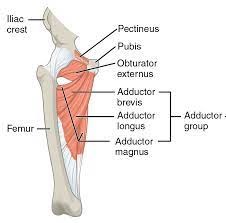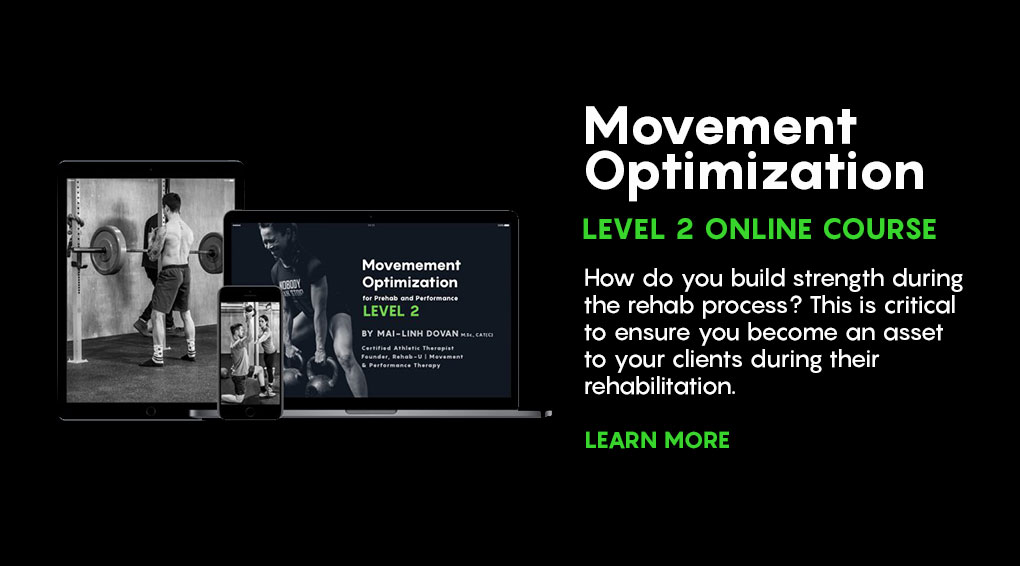
When we think about developing hip power, we typically give the glutes all the glory. After all, they are considered the powerhouse of the hip.
But have you thought about the hip adductors?
What if I told you that adductor function, strength and power are equally, if not more important than glute strengthening?
Unfortunately, the hip adductors don’t get much love in classic bilateral training exercises and even in many unilateral exercises.
In fact, attention to the adductors only seems to come after a groin injury, and even then, they’re not getting all the attention they deserve…
or at least not enough of it.
I remember the case of a young soccer player. His mom brought him to see me because he kept getting groin strains. He would go to therapy and get better, but as soon as he started playing again, he would have a reoccurrence of injury.
I quickly realized it was because he had never really completed everything it takes in the rehab process to prepare his adductors for the demands of soccer.
You see, it takes more than the hip adduction with an elastic band exercise to prepare the hip adductors for the demands of sport such as sprinting, cutting, kicking (a ball, or someone’s ass if you’re a martial artist), and changing direction.
In this article, we will explore why function, strength and power of the hip adductors are important and how to appropriately address these for optimal performance.
Enjoyed this video? Make sure you subscribe to our YouTube channel!
YOUR ADDUCTORS ARE EVERYWHERE
The adductor muscle group (adductor brevis, longus and magnus) as a whole has a biomechanical demand throughout a wide range of hip positions and from a multiplanar perspective.
For example, while the glutes and hamstrings are your primary hip extensors, hence why they get all the glory, the adductor magnus muscles assist with hip extension.
In fact, the adductor magnus along with being an adductor is a dynamic stabilizer for the hip joint, a powerful hip extensor, and flexor, and has the ability to assist internally and externally rotating the hip (1).
What we can essentially conclude is that basically,
when you move your leg in any direction, it’s highly likely the adductor magnus is contributing
During complex and dynamic rotational movements like throwing, striking, kicking or changing directions (which we will discuss later), the adductor groups act bilaterally to control he hip moving on the pelvis and the pelvis moving on the hip. This allows the hip joint to serve as a central pivot for the body.
Speaking of the hip joint, if you haven’t read our article on the importance of having a hip, head to: The Truth About Hip Mobility: Do You Even Have a Hip?
YOUR ADDUCTORS GET YOU INTO POSITIONS
Movements like throwing, striking, kicking and changing directions place athletes into some pretty wild positions, all of which require the capacity of the adductors to absorb forces in a lengthened position.
Focusing on hip adductor strength is of primary importance not only because of its involvement with performance of these movements, but also because of its impact on injury risk.
Absorbing forces at high speeds makes the adductors and groin area particularly susceptible for injury and following injury, particular attention must be paid to restoring this capacity.
RESTORING FUNCTION AND STRENGTH
Where should we start when restoring this capacity?
Now, I may seem to have been making fun of the standing hip adduction with an elastic band exercise in the introduction to this article. I’m only trying to make the point that we can’t stop there.
In the acute rehab stage, we are most concerned with restoring function and strength of the adductors. This involves muscle activation exercises because pain can have an inhibitory effect on muscle function. Isolated exercises are a great way to increase activation in a muscle.
Serner et al. (2013) found high activation of the adductor longus with the hip adduction with an elastic band exercise when they compared muscle activity during 8 different hip adduction exercises (2).
The Copenhagen plank also showed high levels of muscle activation, and is a popular exercise to target the adductors directly:
While isometrics are favorable initially both from a tolerance perspective and from an activation perspective, this exercise can be progressed to include and eccentric and concentric action by lowering and lifting the hips, and then progressed even further to quick, explosive lifts.
WATCH THE MAIN VIDEO TO SEE THESE EXERCISES.
While this is a great place to start, as I mentioned, rehab does not stop there.
MOVING IN THE FRONTAL PLANE
To train the adductors to get athletes into, and out of, the crazy positions they need to, we also need to move away from isolated exercises and start to involve more hip range of motion.
Typical bilateral lower body exercises, and even most unilateral exercises performed in the sagittal plane don’t give the adductors the love and attention they require.
What we need is to get our athletes moving in the frontal plane. Exercises like a simple side-to-side lateral squats include the element of lengthening the adductors under load,
which better prepares the musculotendinous structures for the dynamic requirements of sports
These can then be progressed by increasing acceleration and deceleration speeds:
Moving along the rehab spectrum, while it should be preceded by fundamental strength, end phase power training of the adductors is the final goal.
ROTATIONAL POWER OF THE ADDUCTORS
The adductors help internally rotate the hips to create massive power from the lower body and transfer it up (or out).
As mentioned earlier in the article, during complex and dynamic rotational movements like throwing, striking or changing directions, the adductor groups act bilaterally to control the hip moving on the pelvis and the pelvis moving on the hip. Because of their ability to rotate the hips, the adductors play a huge role in rotational power.
For example, as you wind up or “load” before a throw or a swing, your weight shifts from your back hip to your front hip. As you shift towards your front hip, your hips need to rotate in the opposite direction of your shoulders, creating hip to shoulder separation, which you can read about here.
Loaded, explosive rotational exercises need to be integrated into late phase rehab to best prepare the athlete for these demands. Some studies have shown that a high-intensity exercise matching the proposed injury mechanisms has the potential to significantly prevent re-injury (3). If anything, it prepares the athlete physically as well as psychologically, to get back into the crazy positions of their sport.
You can use a variety of loaded rotational exercises to train the adductors for rotational power:
WATCH THE MAIN VIDEO TO SEE MORE EXERCISES!
LOVE YOUR ADDUCTORS
Like I said, attention to the adductors typically only comes after an injury.
And even though this article is about how to effectively rehab back from injury, it’s probably advisable to routinely include hip adductor function, strength and power from a prevention perspective.
Remember that soccer player? I gave him specific adductor strength and power exercises to include in his off-field training routine…and never saw him again.
Life, and certainly sports, don’t happen in the sagittal plane. Adding frontal plane unilateral exercises and loaded rotational exercises is a sure fire way to not only decrease the risk of injury, but to improve performance.
REFERENCES
- Neumann, D. (2010). Kinesiology of the Hip: A Focus on Muscular Actions. Journal Of Orthopaedic & Sports Physical Therapy, 40(2), 82-94. doi: 10.2519/jospt.2010.3025
- Hölmich, P., Sundstrup, E., & Thorborg, K. (2014). EMG evaluation of hip adduction exercises for soccer players: implications for exercise selection in prevention and treatment of groin injuries. British journal of sports medicine, 48(14), 1108–1114. https://doi.org/10.1136/bjsports-2012-091746
- Petersen, J., Thorborg, K., Nielsen, M. B., Budtz-Jørgensen, E., & Hölmich, P. (2011). Preventive effect of eccentric training on acute hamstring injuries in men’s soccer: a cluster-randomized controlled trial. The American journal of sports medicine, 39(11), 2296–2303. https://doi.org/10.1177/0363546511419277

Mai-Linh Dovan M.SC., CAT(C)
Certified Athletic Therapist
Founder of Rehab-U







Be part of the conversation